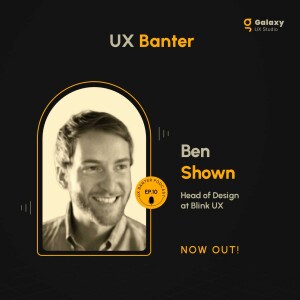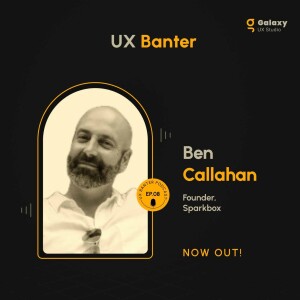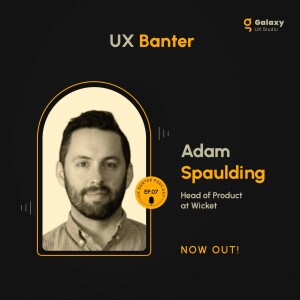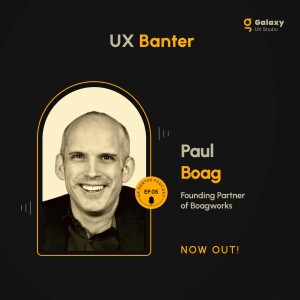Episodes

Wednesday Oct 09, 2024
Designing for Impact: Lessons from Amina ElShazly, S4, Ep. 12
Wednesday Oct 09, 2024
Wednesday Oct 09, 2024
In this episode, we are joined by Amina ElShazly, CTO and Co-founder of UXIT, an accomplished user experience leader with over 11 years of expertise spanning UX strategy, user research, and front-end development. Amina has been instrumental in shaping successful projects across diverse industries while mentoring aspiring designers on ADPList.Discussion points:~ Can you share how your journey as a design professional began? 1:43~ Was your switch from front-end development to UX a conscious decision, or was it something you were pushed into? 5:58~ What differences have you noticed between working as an individual and now as a design leader since becoming an entrepreneur? 7:54~ Rapid fire round 9:57~ As a design leader, do you miss the hands-on practices from earlier in your career, and have you encountered new challenges that surprise you now in a leadership role? 12:53~ How do you integrate new technologies, like AI and blockchain, into your practices and what approach do you take when adopting these changes? 16:19~ What are some common discussion points you address with young women design leads from the Middle East in your mentorship? 17:40~ What advice would you give to your younger self as you were starting your career? 19:36Show notes:~ We thought of creating this company because of our love for UX and to do what we want to do in the best shape.~ When I opened my company, I started to teach other people about what I love, and I focused more on the strategy and the user experience.~ As an individual, there are a lot of rules and regulations... but in our company, we make it in the best shape because everyone has their role in the team.~ Don’t be afraid to ask questions and seek mentorship. Learning from others can accelerate your growth.~ I was just a graduate, and I was interested in the new challenges. So I accepted the offer in user-centered design.~ The more you practice, the more you learn. And learning never stops, so try to learn every day.~ Build a strong network of professionals in your field. Collaboration can lead to incredible opportunities and insightsLinks:LinkedIn: www.linkedin.com/in/amina-elshazly86/ Company website: https://ux-it.com/

Thursday Oct 03, 2024
Thursday Oct 03, 2024
In this episode, we are joined by Aadit Patel and Macarena Zañartu, from NotCo. Aadit is a leader in Applied Machine Learning with over 13 years of experience, while Macarena is an exceptional designer who translates complex solutions for everyday users. Aadit has developed autonomous systems in aerospace, online advertising, FinTech, and biotechnology. Together, they are creating sustainable plant-based foods using advanced AI. Discussion Points:
Can you share your individual journeys that led you to where you are today? 1:56
What restrictions exist for AI in the EU and other regions, and do legal processes make it harder to implement? 8:36
What are the biggest challenges you face when dealing with people who are hesitant to embrace technology? 13:12
How similar was the experience of designing this application to your work on other applications, like banking? What similarities can you point out? 30:11
Rapid Fire Round 35:22
How do you think scientists can currently leverage AI tools and techniques in their research, and what potential do you see for the future? 45:39
What advice would you give to new entrepreneurs looking to follow a similar model of creating innovative solutions with technology, and what challenges should they be aware of? 53:05
Show notes:
From a core technology perspective, we figured out how to efficiently solve a common problem. Any formula, whether it’s toothpaste or a burger, is a combination of ingredients that undergo a process. - Aadit Patel
The A I can do the hard stuff, you know, it can do the hard stuff like the constraints and thinking, and like all these high dimensions, it can be a great assistant for creativity. - Aadit Patel
The way that we work together collaboratively with the machine learning engineers, there’s this whole validation process we do when we’re in that stage that first of all, are we actually solving a relevant problem that is important with that? - Macarena Zañartu
Making people trust that way of working. It's like adapting. The way that they are interacting with this new interface is also a thing about processes, users are going to have to build things that they probably think are not going to work to let the system know what a better recommendation will be. - Macarena Zañartu
The future of food needs to be not just nutritious but it needs to have some functionality that is, is helpful and backed up by potential claims. - Aadit Patel
Don't fall in love with the thing that you're designing, like put it out there, test it iterate on it, and accept feedback, and don't wait until something is done in front of your eyes. - Macarena Zañartu
Links -Aadit Patel’s LinkedIn: - https://www.linkedin.com/in/aaditpatel/ Macarena Zañartu's LinkedIn: https://www.linkedin.com/in/macazeta/ Company website: https://www.notco.com/

Wednesday Sep 25, 2024
Innovating UX Design for a Better Tomorrow - Ben Shown, S4, Ep. 10
Wednesday Sep 25, 2024
Wednesday Sep 25, 2024
In this episode, we are joined by Ben Shown, Head of Design at Blink UX. With over a decade of creative leadership experience, Ben has led design teams to collaborate with top-tier brands like Amazon, eBay, Microsoft, and NASA. We dive into his journey, his expertise in human-centered design, and how he approaches creating seamless digital experiences.Discussion points:
How has your journey been? What steps would you recommend for those who want to follow in your footsteps? 1:41
Do you feel there is a difference in the design approach when working with heavily funded organizations compared to corporate giants like Amazon? 4:19
As a kid, you probably dreamed of working with your nation's space agency (NASA). Do you feel that satisfaction was somewhat achieved? 6:00
How do you define design leadership in your current studio or agency setup, and what processes do you implement to ensure your team's success? 7:12
As a design leader, how do you juggle the diverse responsibilities that come your way? 8:38
Rapid fire round 12:54
Do you think there's a secret to building a sustainable team, tracking progress, and setting a North Star for leadership? 17:26
On BlinkUX.com, there’s information about UX workshop ideas and how to conduct them. Can you tell us more about that? 19:07
Any advice for young followers or those just starting out or looking into a studio practice? 22:46
Show notes:
I remember very distinctly getting into the high school yearbook and getting my hands on digital publishing tools from Adobe, like PageMaker and Photoshop, and just loving that process.
Our job was to untangle that knot—find commonalities through UX research around which stories were the most effective that NASA was telling—and ultimately consolidate those 3,000 websites into one.
Understanding how to create great UX at the government level is a different challenge compared to working with tech clients that have had design embedded in their culture for a long time.
If I could have next-level time management, that would be ideal. I feel like I’ve gotten better at it, but that would definitely be a superpower.
Making sure your design activities are really set up for the end goal is crucial. You need to get people talking, have them take their guard down, and position the activities to help us read between the lines and understand the project's big ambitious goals.
Throughout the course of a project, our clients take a journey in learning user-centered design. We often teach our clients how to run workshops and how to progress in a design project
Links:LinkedIn: www.linkedin.com/in/benkshown/ Company’s Website: www.blinkux.com

Wednesday Sep 18, 2024
Mastering User Interactions with Matt Belge - S4, Ep. 9
Wednesday Sep 18, 2024
Wednesday Sep 18, 2024
In this episode, we’re joined by Matt Belge, Senior Product Designer at Imprivata. With extensive experience in UX design, Matt specializes in creating user-centered solutions that enhance satisfaction and usability. He has a deep background in human-centered innovation, design thinking, and usability research, making him a key voice in crafting effective user experiences.
Discussion points:
With over 25 years in the industry, can you share your journey and some major momentum shifts you've witnessed during this time? 1:13
Given your experience with mission-critical UX, from medical emergencies to identity management, do you think our reliance on these systems has put us in a vulnerable position? 7:37
Considering your work on medical information systems, how do you integrate these systems with security and identity management? 12:39
Rapid fire questions 17:46
Having witnessed the tech evolution from the late seventies to now, what do you think the landscape will look like in 15 to 20 years? 22:23
What career advice would you give to those starting out in the field?? 26:14
Show notes:
When I started, a career in UX did not exist. The closest thing might have been something like human factors, which I didn't even know existed back then.
You don't really notice good user interfaces, you only notice bad ones.
It is the responsibility of UX people to prevent human error. We need to anticipate and prepare for it, even though we can't eliminate it completely.
With regard to artificial intelligence, I feel scared a little bit when I think about it because it has the power to do things that will replace humans or make decisions that humans are used to making.
What I work on is actually the identity management part. It's about making it easy for clinicians to access the systems they need quickly and efficiently.
Thinking through what would happen in catastrophic situations and making sure you have a good contingency plan is part of the user experience.
Links:LinkedIn: https://www.linkedin.com/in/matt-belge-634194/Company’s Websites: www.imprivata.com Matt’s Company Website: www.visionlogic.com

Wednesday Sep 11, 2024
Understanding the Impact of Well-Built Design Systems with Ben Callahan - S4, Ep. 8
Wednesday Sep 11, 2024
Wednesday Sep 11, 2024
In this episode, we are joined by Ben Callahan, founder of Sparkbox and a leading figure in UX strategy with over 13 years of experience. Ben's expertise in creating impactful user experiences and fostering collaboration has earned him great respect in the design community. As a speaker, author, and design system coach, he continues to drive industry innovation. Discussion Points :
Can you walk us through your career journey and share some insights? 1:29
How do you go about educating others on the benefits of a design system? 5:05
How do you recommend implementing a design system? Is an independent code base, a Figma file, or a tool that hosts the design system the best approach? 8:11
Rapid fire round 13:58
Can you share your journey from your early experiences and childhood to your current role at Sparkbox, and how these experiences have shaped your career? 18:09
How do you convince engineering teams to invest in design systems, given that many see it as just a design responsibility? 24:29
Show notes
I quickly fell in love with design and user experience. I kind of left that role and jumped out on my own to explore that opportunity a little bit more.
We spend a lot of time with them thinking about education, helping everybody inside the organization understand what a system is, why it's important, and what it means for them.
We've done some interesting studies to show, just from an efficiency standpoint, how much of an impact a system can have when it's built well and is being used. The numbers are quite staggering.
I think of design systems not as a product, but as a program that has to exist inside an organization. When they're done well, they really become the way we build digital interfaces.
Two-thirds of the effort is in writing really good documentation and training people to understand that's where they go to get the answers they need.
I've got so many insights from people who are out there in the trenches doing this work on a daily basis. If you have questions or ideas on how this work can be done, or if you just need a community of people who can help support you through difficult times, that's really what this is becoming.
Links:LinkedIn: https://www.linkedin.com/in/bencallahan/ Company’s Website: https://sparkbox.com/ Personal Website: https://bencallahan.com/The Question: https://bencallahan.com/the-question -

Wednesday Sep 04, 2024
Future Visions: AI, Privacy, and Lifelong Learning with Adam Spaulding, S4, Ep. 7
Wednesday Sep 04, 2024
Wednesday Sep 04, 2024
In this episode, we are joined by Adam Spaulding, Head of Product at Wicket, who brings extensive experience in product management, with a strong emphasis on customer-centric solutions. His expertise spans strategic initiatives, leadership in software development, and pioneering strategies for customer-led growth, enhancing user experiences at live events and facilities. Discussion Points
Could you share with us the journey that led you to become the accomplished designer and professional you are today? 1:32
How do you foresee the future of privacy evolving over the next 25 years amidst advancing AI technologies? 3:24
How will the convergence of AI, quantum computing, and service design shape the future? 5:42
How do you think privacy will evolve over the next 25 years? 7:16
Do you think we're moving towards a future where technology takes precedence over human priorities? 11:18
Rapid fire round 13:13
What does educational learning mean to you, and how do you see it impacting professionals across different cities? 17:45Show notes -
Every deployment, every feature we deploy, you have to really be sure that it's going to produce the right result that you're looking for.
My objective personally is to make sure the user is served by the tool rather than the user serving the tool
If you're not open and willing to change or to adopt new technologies, it's going to be a real tough road for you.
Always have the growth mindset, always be open in conversation. If you're not growing, you're dying.The future is bright, tech access is everywhere. There's still a billion people on the planet yet to come online.
Learning how to learn is critical because you don't have all the answers, and that's the reason you're there.
Links - LinkedIn: https://www.linkedin.com/in/adamspaulding/ Company website: http://wicketsoft.comPersonal website: https://spauldi.com/

Wednesday Aug 28, 2024
From Design Innovations to Global Influence: Insights by Zac Halbert - S4, Ep. 6
Wednesday Aug 28, 2024
Wednesday Aug 28, 2024
In this episode, we're joined by Zac Halbert, Head of Design at Cortex, a seasoned design leader recognized for his impactful contributions to product and experience design. Zac shares his journey and expertise, offering insights into driving innovation and providing valuable perspectives on achieving design excellence and effective team leadership.Discussion points -
Can you describe your journey leading teams across various organizations, navigating challenges, and driving innovation in product management? 1:21
Do you find it challenging to ensure user advocacy and align product development with cross-functional team cultures, particularly in terms of securing your seat at the decision-making table? 2:58
How has your experience living and working in different places along the West Coast, from California to Portland, shaped your perspective on professional and personal growth? 5:09
Rapid Fire Round 10:26
How essential do you believe technical knowledge or upgrading skills are for individual contributors when working with new AI-based or big data visualization libraries? 15:34
Could you share some insights or common questions you encounter from your mentorship at ADP List? 20:41
What advice would you like to share with those who are just starting out in their careers? 25:32
Show notes -
Shifting from a focus solely on design to understanding broader business goals and collaborating effectively across departments has been pivotal in my career growth.
Technology and remote work have homogenized cultural differences, enabling global collaboration with teams seamlessly.
Letting go of control and trusting team members to execute designs is a significant cultural shift for designers moving into leadership roles
AI enhances efficiency but doesn't replace human creativity. Focus on user empathy and problem-solving skills remains crucial.
Design is crucial in understanding what users want. It's about marrying solutions to real problems and ensuring users feel empowered and satisfied.
Focus on learning and adapting. In 2024, staying updated with design systems and UI kits is essential, but honing problem-solving skills and user empathy is paramount.
Links:LinkedIn: https://www.linkedin.com/in/zachalbert/ Company website: https://www.cortex.io/ ADP List: https://adplist.org/mentors/zac-halbert

Wednesday Aug 21, 2024
Building User Trust: Strategies By Paul Boag , S4, Ep. 5
Wednesday Aug 21, 2024
Wednesday Aug 21, 2024
In this episode, we’re joined by Paul Boag, the Founding Partner of Boagworks and a digital expert with 27 years of experience. Paul’s expertise spans customer experience consulting, conversion optimization, and UX prototyping. As the author of six books and the creator of the pioneering podcast on web design, Paul has made a profound impact on the industry. Discussion Points -
Could you describe your journey in the field of UX? Starting at a time when UX wasn't even a term, how was life and the journey back then? 2:21
How can one effectively communicate the value of UX to individuals or organizations that may not be familiar with it? What strategies have proven successful? 14:38
How should one document and present their approach to selling UX on platforms such as their website? 18:22
Rapid fire round 25:09
What is one piece of advice you would give to someone who is just starting out in their career? 32:25
Can you talk more about conversion optimization and its relation to UX? How do you balance creating urgency with maintaining user trust? 35:56
Show notes - ~ There are also things like cognitive load, and there's loads of psychological ways that you could help somebody have a good experience and make a purchase without resorting to manipulative techniques that ultimately just alienate them.~ Understanding and working with human psychology, rather than against it, can create more positive experiences and outcomes.~ Effective strategies can help people follow through on their intentions by making the decision process smoother and less fraught with immediate resistance.~ It's important to consider the ethical implications of how we design experiences to support positive behavior without causing alienation.~ By planning for future actions, like donating after a pay rise, we can bypass the immediate resistance from our survival instincts.~ Creating opportunities for future commitments allows people to align their actions with their values without triggering loss aversion.~ Our psychology at the point of action is often dominated by immediate concerns and instincts that can prevent us from acting on our longer-term intentions.
Links- Paul’s LinkedIn: https://www.linkedin.com/in/paulboag/ Company website: https://boagworld.com/ Email: paul@boagworks.com Podcast: https://boagworld.com/show/

Wednesday Aug 14, 2024
From Graphics to Great UX: The Journey & Experiences of Christopher Miller, S4, Ep. 4
Wednesday Aug 14, 2024
Wednesday Aug 14, 2024
In this episode, we are joined by Christopher Miller, Principal UX Designer at OneTrust with over a decade of experience. Christopher is a master in design thinking, product design, and service design. He excels in creating seamless user experiences, mentoring UX teams, and collaborating across functions to solve complex user challenges. Discussion points -
How did you start your journey in UX design? 1:27
How does team culture differ in freelancing, agencies, startups, and larger teams, and how does it impact the design process? 3:45
How do you perceive the pressure and mental health challenges that designers often face in their roles? 8:36
Rapid fire round 18:13
Could you tell us more about your experience with teaching and mentoring in your career? 23:22
How can people reach out to you for one-on-one design sessions and mentorship in UX design? 27:26
Do you think it's easy to go out and network, and do you participate in any networking activities in your area? 28:53
What advice would you give your younger self entering UX 10 years ago, and what tips do you have for new professionals today? 34:08
Show notes -
Working at an agency provides more variety of clients, challenges your comfort zone, and pushes you to take on more responsibilities compared to freelancing or working at a larger organization.
Establishing good relationships with product managers and developers is important to collaborate on projects and set constraints effectively.
Learning to say no and establish boundaries is important for mental health when working on multiple projects simultaneously.
Creating design sprints that are separate but aligned with development sprints helps provide clarity on timelines and capacity.
Teaching and mentoring allow you to be the kind of support you wish you had when starting out and help you remember the basics of UX design.
The pandemic has allowed an experiment of teaching based on user experience design, creating an opportunity for virtual one-on-one connections and supporting individuals
Running podcasts is a fun way to connect with other designers and blow off steam by discussing movies and pop culture from a design perspective.
Links -Christopher’s LinkedIn: https://www.linkedin.com/in/uxchrism/Company’s Website: www.onetrust.com Podcasts: www.youtube.com/@whathefuxhttps://popcornandplotholes.transistor.fm/

Friday Aug 09, 2024
Friday Aug 09, 2024
In this episode, we’re joined by Verne Lindner, VP of UX and Design at Roost. With extensive experience in UX design and a strong commitment to accessibility, Verne offers valuable insights into her career journey and the evolution of design systems. She also provides practical advice for aspiring design leaders, sharing how to navigate enterprise and startup environments effectively.Discussion Points:
Could you share insights into your journey in the design field, including your educational background, involvement in design academies, and the path that led to your current role as a design leader? 3:00
How do your childhood, parental background, educational journey, and personal influences shape your UX design work, particularly for startups and various ecosystems? 8:24
Rapid Fire Round 11:46
You have experience working with both enterprises and startups. What is your preference between these two environments, and why? 17:32
How critical is implementing a design system for startups, and do you believe it's essential to establish it early in the process? 23:38
What advice would you offer to the younger generation aspiring to become successful design leaders, based on your journey and experiences? 39:00
Show notes:
I love learning. My favorite thing is following something that seems interesting, and taking the time to explore the path until most, if not all, of my questions are answered.
I believe the most significant aspect, which I've found true for other designers and UX professionals, is the level of self-reliance. Relying on your curiosity, work ethic, and resourcefulness paves a path for personal growth and improvement in life.
The larger the organization, the longer the timelines, allowing for more in-depth research. In startups, decisions are made quickly, and research is conducted on the fly.
There's going to be some sort of interim UI. So, your first job is just trying to make things a little more consistent, eliminating illogical patterns. You aim to bring in something that feels simple, still in the language of the existing UI, creating a cohesive end-to-end experience that aligns with the brand after thoughtful consideration.
In terms of the design system, I believe it's critical for several reasons. Firstly, having a UI built from components that you and the development team maintain and update aligns with your goals. If this isn't the focus, and you're just patching bits of UI without a cohesive system, it could potentially slow you down in the long run.
The business case for accessibility lies in not excluding a portion of your market by disallowing certain individuals from accessing your app. Additionally, it contributes to creating a better overall user experience.
When it comes to applications, game design, or social media content creation and consumption, I believe younger designers should take the lead. Their understanding of the basic physical relationship to devices provides an advantage that might be challenging for those who don't already possess it.
Links -LinkedIn - https://www.linkedin.com/in/vernelindner/Company’s LinkedIn - https://www.linkedin.com/company/joinroost/Company website - https://joinroost.com/

A fun and conversational podcast where the design industry experts share their story, learnings, and the processes they follow to create successful digital products and user experiences.








